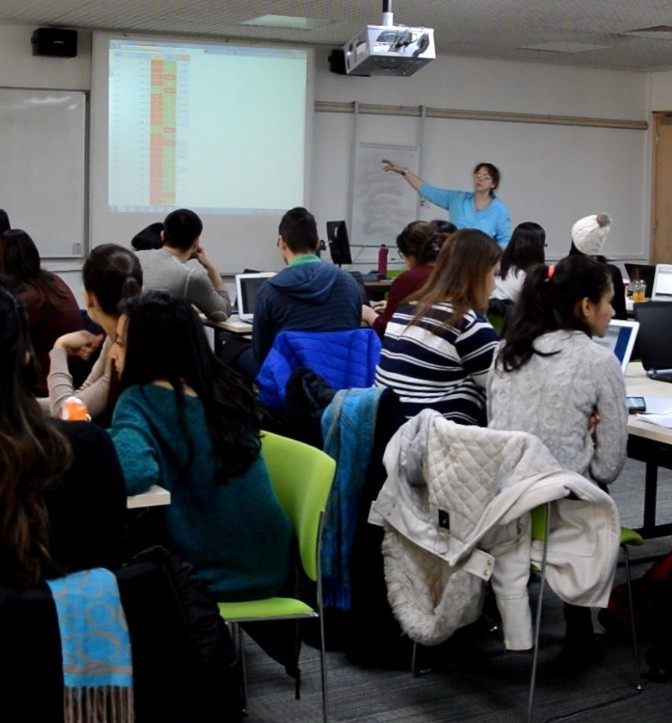
Source: Nicole Brown
What are audience response systems?
As teachers and educators we are always trying to find ways to engage our learners and make learning interesting and accessible for all. In order to keep up-to-date with recent developments within education and to meet the needs of the new generation of learners who grow up in an increased computerised world, I offered a training session on audience response systems. We all know audience response systems as clickers or voting devices from television game shows, but today audience response systems can offer much more than merely allowing participants to cast a vote. Also, many audience response systems available today no longer require specialised equipment, either, but work as web-based applications.
One example: Socrative
In the training session I used www.socrative.com. Personally, I like Socrative for its intuitive use and for the fact that it is available as an app as well as via the common browsers. Socrative allows instructors to devise quizzes, which can be multiple choice, true/false or short answer quizzes, but also to import quizzes from a database of quizzes designed and shared by other teaching practitioners. The quizzes can also be turned into team games, where several teams will race to space by answering the quiz questions correctly. Socrative also allows teachers to add quick questions, again in the form of multiple choice, true/false or short answers. The difference between the quick questions and the quiz questions is that the quizzes have to be prepared in advance, whilst the quick questions could actually come out of the debate that happens in the classroom. By opening up a quick question to be answered students can offer their views on a given topic, which can then be displayed on the classroom screen as a stimulus for further discussion. The teacher can also edit the responses and ask the students to vote for the most popular answer to a question. Socrative also provides the opportunity to have reports sent to the teacher’s email address, so that there is a clear record of the lesson available afterwards.
Demonstrating socrative in teaching
In the session I ran I demonstrated some of the functions of Socrative by embedding specific tasks within the actual content of a teaching reflection session. The topic of the session was classroom management and I had planned specific quiz questions based on reading the learners had to do in their own time before coming to the session. The students’ answers were displayed on the classroom screen, but the students’ names were hidden. I also demonstrated the short answers, where I asked students to respond to bigger questions about the concepts of classroom management and how they interpreted classroom management. In this case I displayed the students’ names. I used another set of Socrative quiz questions as part of a reflection task, where students were required to reflect on specific readings they were given in the session. Finally, as part of an evaluation of Socrative as a learning tool I again asked for short answers and after deleting duplicates, I offered these questions up for a vote, so students could vote for their favourite responses. I also showed the reports of the tasks so that my learners would see the full functionality of the app.
Why use audience response systems in teaching?
For many of my learners this was the first time that they experienced an audience response system and/or Socrative, which I had known about. Therefore, I deliberately set my learners up to fail on some of the questions so that they would experience what it feels like to have the failure displayed on the screen. Students commented on how the display of their responses made them feel uncomfortable even though their names were hidden. This was an important learning point, as teachers and educators need to consider the learners’ feelings. Overall, however, students enjoyed the use of Socrative as a tool for assessing and engaging pupils in class. Personally, I think some of the activities are no different from completing a worksheet, but because there is the use of gadgets involved there may be an additional appeal for learners. My learners also found that they were able to see and discuss a wider range of opinions than usual. This is because group work usually comprises of 4 to 6 learners, but in this case all 35 students’ views were visible. And this was a very important factor, as it meant that quieter students, or those that are more introvert and shy were also heard. On the other hand, students who could potentially be taking over discussions suddenly became quieter. As such, Socrative was experienced as a great leveller, and for that reason many of my learners stated they would try to implement it in their own teaching.
Final words of advice
As with all strategies there are practicalities that need to be considered. My advice would be to have a Plan B for every Socrative lesson because it could be that the internet doesn’t work or that not all pupils have access to a gadget or laptop. And finally, overdoing one strategy will become boring and repetitive over time, too, so using Socrative is fantastic, but we shouldn’t start to rely solely on audience response systems.
Leave a message: